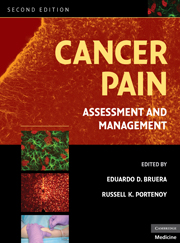Book contents
- Frontmatter
- Contents
- Contributors
- Preface
- SECTION I MECHANISMS AND EPIDEMIOLOGY
- SECTION II EPIDEMIOLOGY AND SYNDROMES
- SECTION III ASSESSMENT
- SECTION IV PHARMACOLOGICAL TREATMENT
- SECTION V OTHER INTERVENTIONAL STRATEGIES
- SECTION VI REHABILITATION AND PSYCHOLOGICAL INTERVENTIONS
- 18 Psychological interventions for cancer pain
- 19 Rehabilitation medicine interventions
- SECTION VII THE ROLE OF ANTINEOPLASTIC THERAPIES IN PAIN CONTROL
- SECTION VIII PAIN IN SPECIAL POPULATIONS
- SECTION IX DIFFICULT PAIN PROBLEMS
- SECTION X SYSTEMS OF CARE
- Index
- Plate section
- References
19 - Rehabilitation medicine interventions
from SECTION VI - REHABILITATION AND PSYCHOLOGICAL INTERVENTIONS
Published online by Cambridge University Press: 06 July 2010
- Frontmatter
- Contents
- Contributors
- Preface
- SECTION I MECHANISMS AND EPIDEMIOLOGY
- SECTION II EPIDEMIOLOGY AND SYNDROMES
- SECTION III ASSESSMENT
- SECTION IV PHARMACOLOGICAL TREATMENT
- SECTION V OTHER INTERVENTIONAL STRATEGIES
- SECTION VI REHABILITATION AND PSYCHOLOGICAL INTERVENTIONS
- 18 Psychological interventions for cancer pain
- 19 Rehabilitation medicine interventions
- SECTION VII THE ROLE OF ANTINEOPLASTIC THERAPIES IN PAIN CONTROL
- SECTION VIII PAIN IN SPECIAL POPULATIONS
- SECTION IX DIFFICULT PAIN PROBLEMS
- SECTION X SYSTEMS OF CARE
- Index
- Plate section
- References
Summary
Introduction
Rehabilitation has become an increasingly prominent tool for cancer pain management. Generally speaking, rehabilitation may be defined as the process of restoration and maximization of quality of life through enhancing function and mitigating disability. A person's function is influenced by abilities and limitations, and includes domains of physical health, emotional status, intellect/cognition, vocation and vocational activity, social activity, and role fulfillment. The burden of pain is manifested in an individual through suffering but also through impaired function, activity, and alterations in social roles and self-image. Successful pain management can improve mobility, function, and quality of life. Pain management is an important component in the successful rehabilitation of the cancer patient.
Pain can limit one's function. Conversely, rehabilitation techniques help reduce and manage pain.
The pain management and functional improvement goals are never exclusive and frequently coexist for cancer patients throughout the course of the disease. Functionally oriented efforts may involve the application of strengthening, coordination, balance, and other training exercises; use of therapeutic equipment; and adaptive education. This chapter focuses on interventions directed toward pain management. Some movement-based therapies are used for pain management, although their more frequently recognized benefits are strength, coordination, endurance, and balance.
Rehabilitation philosophy
The rehabilitation physician's expertise is based on musculoskeletal and neurological anatomy and pathophysiology. Rehabilitation has traditionally been viewed as an intervention used after a chronologically discrete onset of disability, such as may follow a cerebrovascular accident, traumatic spinal cord injury, or amputation.
- Type
- Chapter
- Information
- Cancer PainAssessment and Management, pp. 354 - 376Publisher: Cambridge University PressPrint publication year: 2009



